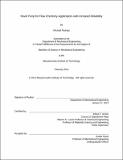| dc.contributor.advisor | Klavs F. Jensen. | en_US |
| dc.contributor.author | Rodrigo, Michael, S.B. Massachusetts Institute of Technology | en_US |
| dc.contributor.other | Massachusetts Institute of Technology. Department of Mechanical Engineering. | en_US |
| dc.date.accessioned | 2014-12-08T18:09:50Z | |
| dc.date.available | 2014-12-08T18:09:50Z | |
| dc.date.copyright | 2014 | en_US |
| dc.date.issued | 2014 | en_US |
| dc.identifier.uri | http://hdl.handle.net/1721.1/92071 | |
| dc.description | Thesis: S.B., Massachusetts Institute of Technology, Department of Mechanical Engineering, 2014. | en_US |
| dc.description | This electronic version was submitted by the student author. The certified thesis is available in the Institute Archives and Special Collections. | en_US |
| dc.description | Cataloged from student-submitted PDF version of thesis. | en_US |
| dc.description.abstract | Commercial pumps tested at MIT's Jensen lab for applications pumping highly corrosive materials at medium pressure (100-300 psi) and a low flow rate (less than 50 mL/min) have proven unreliable. The most common failures observed have been check valve failure and insufficient chemical compatibility. Some of these pumps use dual reciprocating pistons to drive the fluid, requiring the use of four check valves. This lowers the reliability of the pump as a whole to an undesirable level. A novel pump system design could operate without the need for any check valves. Operating three diaphragm pumps in series creates a pseudo-peristaltic pump, but requires check valves on both sides of each diaphragm pump. Instead, a diaphragm pump was designed such that the diaphragm can completely seal at the apex of each stroke, eliminating the need for check valves between the pumps. Proper timing of the draw and pump phases of the cycle of each pump eliminates the need for check valves at the ends of the series as well. Thus, each stroke of the pump is able to drive fluid forward and seal to allow adjacent pumps to draw effectively and prevent them from creating backflow. Additionally, current pumps have problems with chemical compatibility due to poor material selection. Thus, this new pump could be made to be more reliable and more robust against corrosion by choosing materials with high chemical compatibility. The scope of this thesis is only the design of one of the diaphragm pumps to be used within the three pump system described above. | en_US |
| dc.description.statementofresponsibility | by Michael Rodrigo. | en_US |
| dc.format.extent | 21 pages | en_US |
| dc.language.iso | eng | en_US |
| dc.publisher | Massachusetts Institute of Technology | en_US |
| dc.rights | M.I.T. theses are protected by copyright. They may be viewed from this source for any purpose, but reproduction or distribution in any format is prohibited without written permission. See provided URL for inquiries about permission. | en_US |
| dc.rights.uri | http://dspace.mit.edu/handle/1721.1/7582 | en_US |
| dc.subject | Mechanical Engineering. | en_US |
| dc.title | Novel pump for flow chemistry applications with increased reliability | en_US |
| dc.type | Thesis | en_US |
| dc.description.degree | S.B. | en_US |
| dc.contributor.department | Massachusetts Institute of Technology. Department of Mechanical Engineering | |
| dc.identifier.oclc | 897370921 | en_US |
